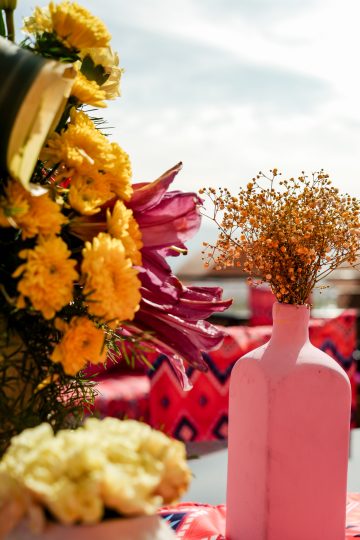From “Subho Drishti” to “Sindoor Daan”: Bengali Wedding Rituals
Bengali weddings are a beautiful tapestry of rich cultural traditions, vibrant festivities, and profound symbolism. Known for their artistic flair and emphasis on auspicious timings, these weddings blend ancient rituals with heartfelt modern adaptations. Let’s explore some key ceremonies that define a Bengali wedding.
The Journey to Union: Pre-Wedding & Wedding Day Rituals
Bengali weddings typically span several days, each with its own charm.
- Aashirbaad: This is often the formal engagement, where elders from both families bless the couple with gifts (often gold jewelry for the bride) and rice and trefoil leaves. It signifies the acceptance of the alliance.
- Aiburo Bhaat: A fun, emotional “last meal as a bachelor/bachelorette.” Family and friends treat the bride and groom to a lavish traditional feast, often accompanied by singing and dancing. It’s akin to a bridal shower or bachelor party.
- Gaye Holud (Haldi): A purifying and beautifying ritual. Turmeric paste is applied to the groom first, then the remaining paste, along with new clothes and gifts, is sent to the bride’s home, where it’s applied to her. This signifies blessings and a radiant glow for the wedding day.
- Shankha-Pola: An important ritual for the bride. After her Haldi, married women adorn her hands with red (pola) and white (shankha) bangles, made from conch shells and coral. These symbolize a married woman and are believed to bring prosperity.
- Bor Boron: The groom’s arrival (Bor Jatri or Baraat) at the wedding venue is a grand affair, often with music and dancing. The bride’s mother welcomes him with an aarti (a tray with a lamp), sweets, and water, symbolizing a warm reception into her family.
- Potto Bastra: The bride’s family presents the groom with new attire, which he changes into for the main wedding rituals. This symbolizes the family’s acceptance and love for their new son-in-law.

- Saat Paak & Subho Drishti: The bride, seated on a piri (wooden stool) and covering her face with betel leaves, is carried by her brothers around the groom seven times (Saat Paak). After these circles, they finally meet face-to-face in the Subho Drishti (auspicious first glance), a key moment filled with cheers and playful anticipation.
- Mala Bodol: The playful exchange of garlands between the bride and groom, usually three times, symbolizing their mutual acceptance and respect. It’s often a lighthearted moment with family and friends teasingly lifting the bride and groom to make the exchange difficult.
- Sampradan (Kanyadaan): The emotional moment where the bride’s father or a respected elder formally “gives away” the bride to the groom, entrusting her happiness to him.
- Yagna & Saptapadi: The couple sits before the sacred fire (Agni), with a priest chanting Vedic hymns. They take seven steps (Saptapadi) around the fire, each step symbolizing a sacred vow for their married life (e.g., for prosperity, health, happiness, progeny).
- Anjali/Khoi Porano: The bride’s brother places puffed rice (khoi) in her hands, which the couple then offers to the sacred fire, seeking blessings for a prosperous future.
- Sindoor Daan & Ghomta: The most iconic Bengali ritual. The groom applies vermillion powder (sindoor) to the bride’s hair parting with a ring or konke (a traditional rice measuring utensil). Immediately after, her head is covered with a new saree (lajja-bastra) from the groom’s family, officially marking her as a married woman.



Post-Wedding Joy & New Beginnings
The celebrations continue as the bride is welcomed into her new home:
- Bidaai: The emotional farewell where the bride bids goodbye to her paternal home, often throwing handfuls of rice over her head backward, symbolizing her gratitude and wishes for prosperity for her family as she leaves.
- Bodhu Boron: The bride’s grand welcome into the groom’s home by his mother, often with an aarti and by having her step into a vessel of alta (red dye) and milk, symbolizing the entry of Goddess Lakshmi.
- Kaal Ratri: A unique tradition where the newlyweds spend their first night in separate rooms after the wedding ceremonies, believed to ward off evil.
- Bou Bhat & Phool Sajja: The day after, the groom’s family hosts a reception (Bou Bhat), formally introducing the bride. The bride often cooks her first meal for the family. Later, the couple’s bed is decorated with flowers (Phool Sajja) for their first night together.
Modern Adaptations
While traditional elements remain strong, modern Bengali weddings often see adaptations:
- Condensed Rituals: Families may choose to shorten certain ceremonies or combine pre-wedding events to fit busy schedules.
- Contemporary Attire: While traditional silk sarees (like Banarasi) remain popular, brides might opt for lighter fabrics or contemporary designs for some functions. Grooms may choose modern sherwanis instead of traditional Dhotis for some events.
- Destination Weddings: Many Bengali couples are now opting for destination weddings in locations like Jaipur, blending their rich traditions with grand palace or resort settings.
- Personalization: Couples infuse their personalities into decor, music, and food, making the celebrations unique to them.
- Photography & Videography: High emphasis is placed on capturing every ritual beautifully, blending candid shots with traditional poses to create stunning visual narratives.
A Bengali wedding is a heartfelt celebration of love, family, and cultural heritage, whether rooted in strict tradition or infused with modern flair.

